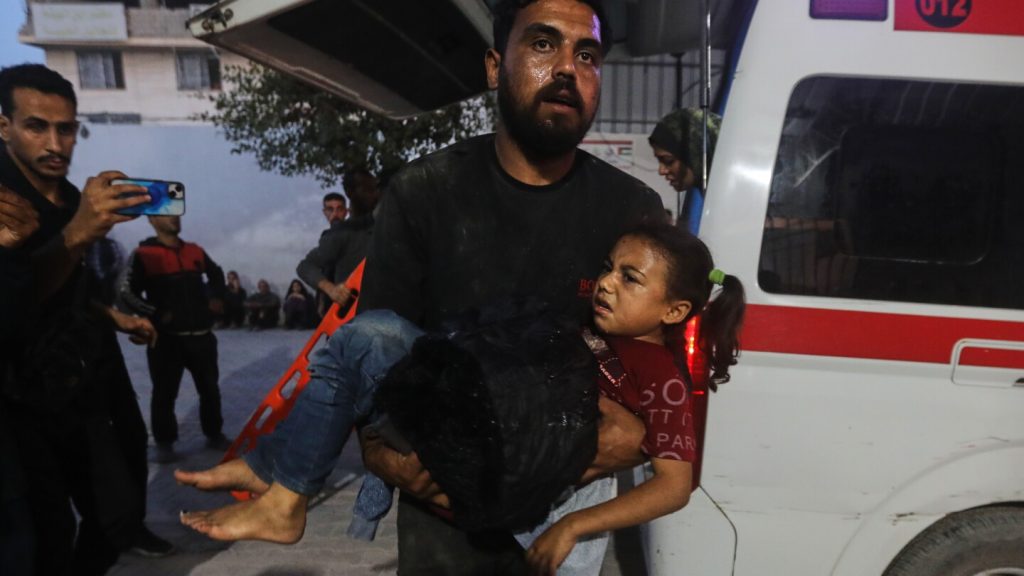The fragile ceasefire in the Gaza Strip was shattered on Saturday as Israeli aircraft launched airstrikes targeting sites affiliated with Hamas, raising concerns about the continued volatility of the situation. The strikes, described by Israel as a response to gunfire directed at its forces, resulted in a significant loss of life and renewed fears for civilians caught in the crossfire, particularly in areas like Deir al-Balah. According to reports, at least 24 Palestinians were killed and 54 injured, including children, highlighting the devastating impact of the ongoing conflict.
Escalation of Violence Despite Ceasefire in Gaza
The recent Israeli attacks mark a disturbing escalation, occurring despite a ceasefire that began on October 10th. Netanyahu’s office claims the operation eliminated five senior Hamas members. However, the details surrounding these casualties remain contested, with Hamas officials denouncing the strikes as a deliberate attempt to sabotage the truce.
The incidents, occurring just days before a planned US-backed security and governance arrangement for Gaza approved by the UN Security Council, threaten to derail efforts towards long-term stability. This arrangement envisions an international force for stabilization and a transitional authority overseen by figures like Donald Trump, potentially leading towards the establishment of an independent Palestinian state.
The resumption of hostilities sadly echoes past patterns. Israel has previously carried out similar strikes in response to reported attacks during periods of ceasefire. Just this week, before Saturday’s events, fatalities reached at least 33 Palestinians in a 12-hour period between Wednesday and Thursday, with women and children disproportionately affected.
Devastation in Deir al-Balah and Other Areas
The attacks weren’t isolated to one location. Several areas across the Gaza Strip bore the brunt of the Israeli assault. In Deir al-Balah, a strike hit a residential building, claiming three lives, including a woman, according to Al-Aqsa Hospital.
Khalil Abu Hatab, a resident of Deir al-Balah, described the harrowing experience to reporters: “Suddenly, I heard a powerful explosion. Looking outside, I saw smoke engulfing the entire area. I couldn’t see anything. I covered my ears and started shouting at others in the tent to run.” He continued, “When I looked again, I realized the upper floor of my neighbor’s house had disappeared.” His words paint a stark picture of the fear and destruction plaguing the region, reinforcing the sentiment that “this is a fragile ceasefire. This isn’t a life we can live. There is no safe place.”
Further attacks were reported in other parts of the Gaza Strip. In Gaza City’s al-Rimal neighborhood, an airstrike targeted a vehicle, resulting in the deaths of 11 individuals and the injury of over 20, many of them children according to hospital director Ramy Mahana. A similar strike near al-Awda Hospital in central Gaza killed at least three people and injured another 11, again with a majority of the wounded being children according to Mohammed Abu Salmiya, the center’s director. Another strike in the Nuseirat refugee camp claimed the lives of at least seven, including a child, and wounded 16 others.
These specific events underscore the urgent need for a lasting peace, discussed within the context of the Gaza ceasefire, and demonstrate the inherent risks to civilians even during periods of relative calm.
Israeli Justification and Hamas’ Response
The Israeli military (IDF) issued a statement justifying the strikes, claiming they were carried out after a “gunman” fired at troops in southern Gaza, utilizing a route intended for humanitarian aid. The IDF characterized this as a “blatant violation” of the ceasefire and confirmed no soldiers were injured. They also reported killing 11 “terrorists” in Rafah and arresting six attempting to escape an underground facility, as well as killing two others who crossed the border from northern Gaza.
However, Hamas has vehemently dismissed these claims and accused Israel of fabricating pretexts to avoid adhering to the ceasefire agreement. Ezzat al-Rishq, a member of Hamas’ political bureau, issued a statement calling upon the United States and other mediators to compel Israel to fully implement the terms of the truce and halt what he termed a “war of extermination”.
The Humanitarian Crisis and Ongoing Protests
The conflict continues to unfold against a backdrop of a deepening humanitarian crisis in Gaza. The Ministry of Health in Gaza reports that 69,733 Palestinians have been killed and 170,863 injured since the start of the Israeli offensive, triggered by the Hamas attack on southern Israel on October 7, 2023. This attack resulted in the deaths of approximately 1,200 people and the capture of over 250 hostages, most of whom have since been returned, though the remains of three still remain in Gaza.
The reported death toll is rising even during the ceasefire, not just from renewed strikes, but also as bodies are recovered and identified from earlier phases of the war. Importantly, the Ministry of Health does not differentiate between civilians and combatants in its overall figures, but acknowledges that the majority of fatalities include women and children.
Meanwhile, protests have erupted in Israel, with citizens demanding a formal investigation into the events surrounding the October 7th attack. Rafi Ben Shitrit, father of Sergeant First Class Shimon Elroi Ben Shitrit, stated, “The government of Israel failed in its most important mission: to protect its children, to protect its citizens, and to not leave our soldiers on the battlefield without rescue and without help.”
As the situation remains highly volatile, the international community must prioritize a durable ceasefire and address the urgent humanitarian needs of the Palestinian people. The latest escalation serves as a grim reminder of the fragility of peace and the devastating consequences of continued conflict in the Gaza Strip. The pursuit of a just and lasting resolution, including consideration of the proposals for a future Palestinian state, is more critical than ever.

